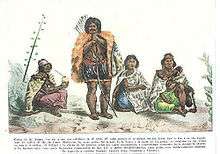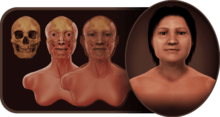Indigenous peoples in Uruguay
Indigenous peoples in Uruguay, or Native Uruguayans, are a very small share of the population.[3]



Scholars do not agree about the first settlers in what is now Uruguay; but there is evidence that there was human presence some 10,000 years BCE, the Homo catalanensis culture. Indigenous Uruguayans disappeared in the 1830s, and with the exception of the Guaraní, little is known about these peoples, and even less about their genetic characteristics.[4]
The Charrúa peoples were perhaps the most-talked-about indigenous people of the Southern Cone in what was known as the Banda Oriental.[5] During pre-colonial times Uruguayan territory was inhabited by small tribes of nomadic Charrua, Chana, Arachan and Guarani peoples. They were a semi-nomadic people who survived by hunting, fishing and gathering and probably never reached more than 10,000 – 20,000 people.[6]
It is estimated that there were about 9,000 Charrúa and 6,000 Chaná and Guaraní at the time of contact with the Spanish in the 1500s. By the time of independence, some 300 years later, there were only about 500 native peoples remaining in Uruguay. The cause of the decline in native populations was disease, as well as intermarriage. With little immunity to these diseases, native peoples and culture were gradually diminished.[7]
Native peoples had almost disappeared by the time of Independence as a result of European diseases and constant warfare. European genocide culminated on April 11, 1831 with the Massacre of Salsipuedes, where most of the Charrua men were killed by the Uruguayan army on the orders of President Fructuoso Rivera, and the remaining 300 Charrua women and children were divided as household slaves and servants among Europeans. By 1840 there were only 18 surviving Charrua in Uruguay.[8]. According to the history professor and journalist Lincoln Maiztegui Casas, “the disappearance of the Charrúa people was a gradual process that took more than 200 years, and the root cause was territorial occupation by Europeans”.[9]
Other significant tribes were the Minuane, Yaro, Güenoa, Chaná, Bohán, Arachán.
Languages once spoken in the area include Charrúa, Chaná, Güenoa, Guaraní.
Nowadays a minor percentage of Uruguayans have indigenous descent.[10][11] According to the 2011 Census, 2.4% of the population reported having indigenous ancestry.[12] A 2009 DNA study in the American Journal of Human Biology showed a genetic composition of 92% European, 7% African, and 1% Native American in Montevideo.[13]
See also
- Localidad Rupestre de Chamangá
- Uruguayan people
- Indigenous peoples in South America
- Hombre del Catalanense (in Spanish)
References
- Moraes, Cícero. "A "Avó" dos Uruguaios" (in Portuguese). Archived from the original on 20 January 2019. Retrieved 20 January 2019.
- "Reconstrucción 3D de Cráneo prehistórico del Uruguay". Portal de Museos del Uruguay (in Spanish). Ministry of Education and Culture (Uruguay). Archived from the original on 20 January 2019. Retrieved 20 January 2019.
- "South America :: Uruguay — The World Factbook - Central Intelligence Agency". www.cia.gov.
- Sans, Monica; Figueiro, Gonzalo; Sanguinetti, Carlos; Echarte-Rafaelli, Lourdes; Portela, Cecilia; Taranto, Luis; Pizzarossa, Carlos; Oliver, Roberto; Manikowski, Rosana; Barreto, Isabel; Hidalgo, Pedro; Berro, Guido. "The last Charrua Indian; (Uruguay): analysis of the remains of Chief Vaimaca Per". Nature Precedings – via www.academia.edu.
- Burford, Tim. Uruguay. Bucks, UK: Bradt Travel Guides, 2011. ISBN 978-1-84162-316-0.
- Gibbon, S.; Santos, R.; Sans, Mónica (November 15, 2011). "Racial Identities, Genetic Ancestry, and Health in South America: Argentina, Brazil, Colombia, and Uruguay". Springer – via Google Books.
- McDermott, Alicia. "The Last of the Charrua: The Honored Warrior Tribe of Uruguay". www.ancient-origins.net.
- Jermyn, Leslie (August 18, 1999). "Uruguay". Marshall Cavendish – via Google Books.
- "Uruguay and the memory of the Charrúa tribe – ThePrisma.co.uk".
- Da Silva Villarrubia, Santiago Katriel (14 July 2011). "Dra. Sinthia Pagano. Un Estudio Detectó 38% de Sangre Aborigen en la Población Uruguaya - En Uruguay hay 115.118 descendientes de indígenas". Mario Delgado Gérez (in Spanish). LaRed21 Comunidad. Retrieved 6 February 2013.
- Da Silva Villarrubia, Santiago Katriel (27 August 2011). "Censo 2011. Organizaciones Sociales Llaman a Decir "Sí" Para Reconocer sus Etnias - Censo: afrodescendientes e indígenas hacen campaña". Matías Rotulo (in Spanish). LaRed21 Comunidad. Retrieved 6 February 2013.
- "Atlas Sociodemografico y de la Desigualdad en Uruguay , 2011: Ancestry" (PDF) (in Spanish). National Institute of Statistics. Archived from the original (PDF) on 2014-11-13.
- Bonilla, Carolina (2004). "Substantial native American female contribution to the population of Tacuarembó, Uruguay, reveals past episodes of sex-biased gene flow". American Journal of Human Biology. 16: 289–297. doi:10.1002/ajhb.20025. PMID 15101054.
External links
- Renzo Pi Hugarte (1969). "El Uruguay indígena" (PDF). Nuestra Tierra. Retrieved 12 May 2015. (in Spanish)
| Wikimedia Commons has media related to Indigenous peoples of Uruguay. |
.svg.png)